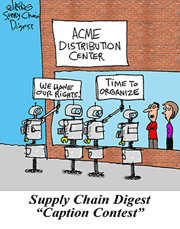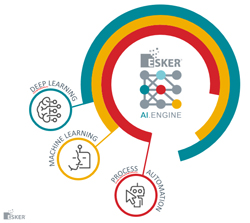2019 Supply Chain Predictions from the Analysts Part 2
Milking (interesting) predictions for 2019 from a virtual panel of supply chain gurus and then the analysts at Gartner for several weeks now, I am winding it down this week with my summary of what I think are of the most interesting supply chain predictions from the analysts at IDC Research.
You can find those columns here: Supply Chain Guru Predictions for 2019, Supply Chain Guru Predictions for 2019 Part 2, and 2019 Supply Chain Predictions from the Analysts Part 1.
| GILMORE SAYS: |
Not that the digital assistant makes all decisions, but it makes the routine, operational, and rote decisions that fall within acceptable parameters.
IDC
WHAT DO YOU SAY?
Send us your
Feedback here
|
The IDC analysts include Victoria Brown, Simon Ellis, Mickey North Rizza, John Santagate, and Sampath Kumar Venkataswamy.
Before making their predictions, the IDC analysts note that while digitization is a key theme for 2019 as it was last year, something interesting is happening. The supply chain, IDC says, is increasingly viewed by manufacturers and retailers as a critical function for their future success.
"As we have noted in recent research, the supply chain is moving from "cost center" to "opportunity center." If companies are going to embrace new business models, or digitally enable older ones, they are going to need a modern, capable supply chain to do it," IDC smartly notes.
IDC as usual provides 10 supply chain predictions for 2019. Here are a selection of my favorites:
Similar to Gartner last week, IDC is big on autonomous mobile robots in distribution, predicting that by 2020, 65% of ecommerce operations will make use of autonomous mobile robots within their order fulfillment processes, thus helping increase productivity by over 100%.
Over 100% - that's a big number.
IDC first notes the core issues that are driving interest in mobile robots in the DC.
For example, traditional approaches to order fulfillment involve a significant amount of non-value-adding travel. Commonly, a human worker in the fulfillment center takes a pick order, pushes a cart throughout the facility, fills the cart with items on the order, and finally pushes the cart back to the packing station where the cart is left with an order packer who prepares the order for shipping.
Then the order picker takes another order and goes through the process again. This process involves much walking from point to point. In addition, many if not most large DCs depend on sometimes a small army of temporary worker to meet seasonal demand spikes.
A number of years back now, Kiva Systems in effect created the "goods to picker" concept with its orange robots bringing inventory to stationary pickers, before it was in effect taken on the market after being acquired by Amazon in 2012.
Lots of other vendors have since brought mobile robots to market, with a variety of applications and processes.
"Autonomous mobile robots in the fulfillment center are connected to mobile devices," IDC says. "This technology, in addition to taking on material movement, is a connected asset that can be integrated into the business systems and become a valuable part of the IoT and digital transformation strategy of the ecommerce fulfillment center."
IDC then offers this smart advice: When considering/deploying mobile robots, it is imperative to communicate openly with workers. "They must understand that the deployment of this technology is meant to augment their capabilities and open up new opportunities and that it is not a replacement for human labor in the ecommerce fulfillment center," IDC says.
I would say that is largely true for mobile robots, maybe not for other DC automation.
Next up: By 2024, one-third of large manufacturers will have moved to using actual demand data instead of short-term forecasts, resulting in an OTIF delivery improvement of 2 percentage points on average.
 That is intriguing for sure. What's behind that prediction? That is intriguing for sure. What's behind that prediction?
IDC first notes that the ability for a supply chain to meet unexpected demand is actually the result of planning decisions made often months before. A supply chain tied too rigidly to a forecast will find itself unable to respond to material variations outside that forecast due to a lack of capacity, materials, or broad flexibility.
However, IDC says that "As data sets become more commonplace and accurate, from traditional sources like ERP and emerging ones like social media and sensors (IoT), it is conceivable that short-term forecasting will give way completely to replenishment based on actual demand."
IDC argues that demand visibility is much better today than three years ago, and there's every reason to believe it will be progressively better three years from now. I think that is largely true, though few companies yet leverage that visibility very well.
Part of the change will involve technology, but changing supply chain structures will also be key.
"Recognizing the need for more flexible supply-side capabilities to engage across different channels and customer groupings, manufacturers are already moving away from the restrictive supply organizations of the past decade," IDC says. "The components are increasingly in place, we believe, to transform demand replenishment from one that is primarily forecast-based to one that is response- based. A supply chain that can operate the replenishment process in real time should not constrain itself to the "quaint" notion of a forecast."
Forecasts are now quaint. That is an interesting view. But how can you really build that type of flexibility?
That, alas, IDC does not in its predictions document make clear. But I will get that clarity before long. I will though say the decades old hierarchical planning paradigm is clearly under some assault.
There was a sort of related prediction from IDC saying that we will see much more planning automation and the rise of "touchless" Sales and Operations Planning processes, but I am going to go with this one: By 2023, talent shortages in the supply chain for 75% of the top 500 manufacturers worldwide will largely have been mitigated by the use of supply chain digital."
So let's dig into this provocative prediction.
IDC notes there has been a lot of handwringing relative to a supposed supply chain talent shortage for a number of years now.
My view, and I think that of IDC: There is some truth to this, but also some level of exaggeration.
Regardless, IDC says much of the talent gap is likely to be mitigated by the use of modern, digital technologies such as Cloud networks, advanced analytics, blockchain, or AI.
More interesting is IDC's view on "digital assistants," which IDC says will involve AI that is able to make operational/tactical decisions in lieu of humans, thus relieving the latter for more strategic work (or "looking for other opportunities," as they say).
"The notion of a thinking supply chain is precisely this," IDC says. "Not that the digital assistant makes all decisions, but it makes the routine, operational, and rote decisions that fall within acceptable parameters. Decisions that fall outside of these parameters are elevated for human decision making. In some ways, this starts to look like a next-generation supply chain control tower."
As with mobile robots, IDC is optimistic on the jobs impact of digital assistants, recommending that companies "socialize idea of automation and AI internally to ensure that the workforce understands the implications, not as technology instead of people but as technology with people."
As noted before, I am more pessimistic on automation and jobs.
But there you have it. Some very interesting stuff from IDC.
Any reaction to these IDC predictions? What resonates with you? What are some of your 2019 supply chain predictions? Let us know your thought at the Feedback button below. |



![]()

![]()

![]()













